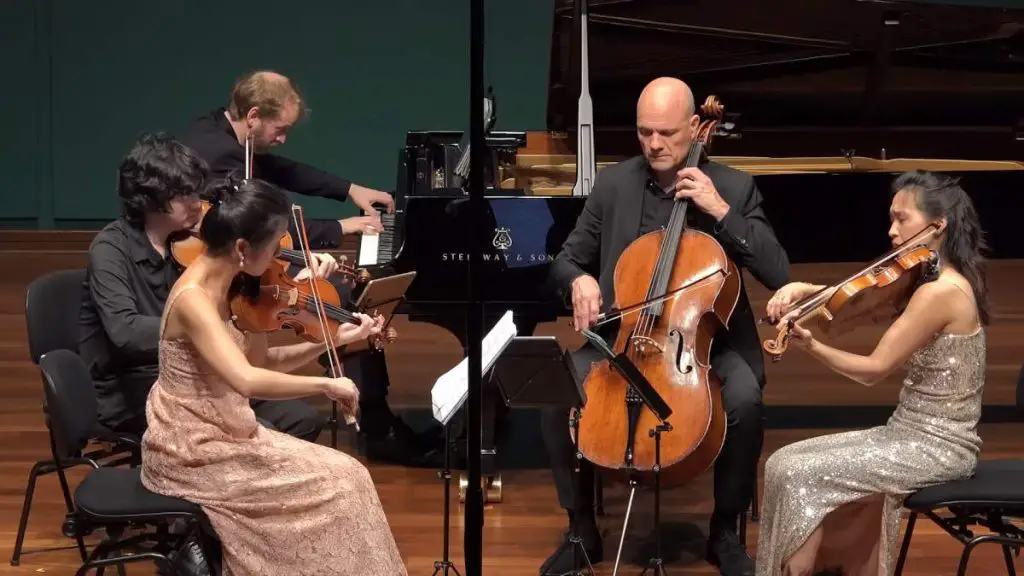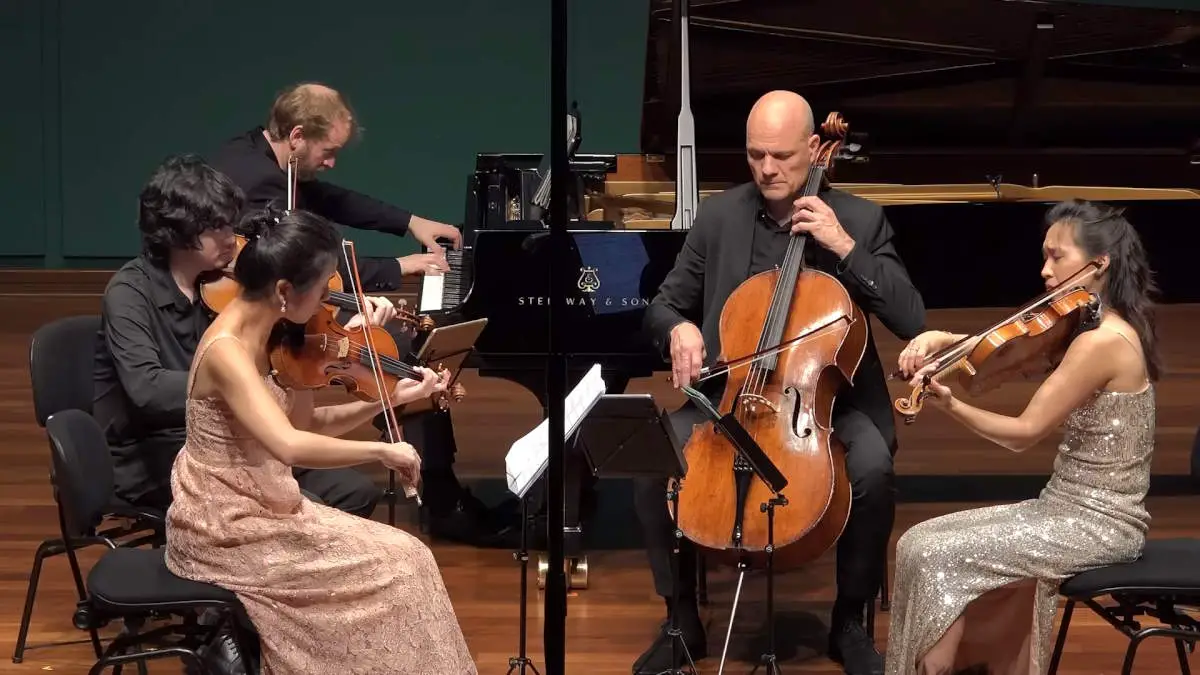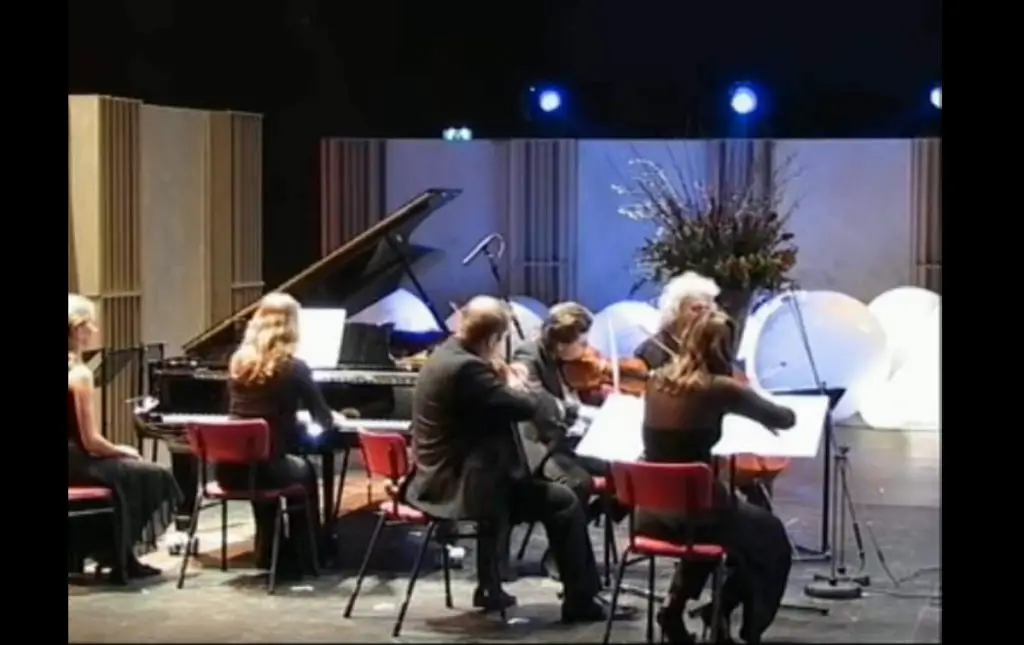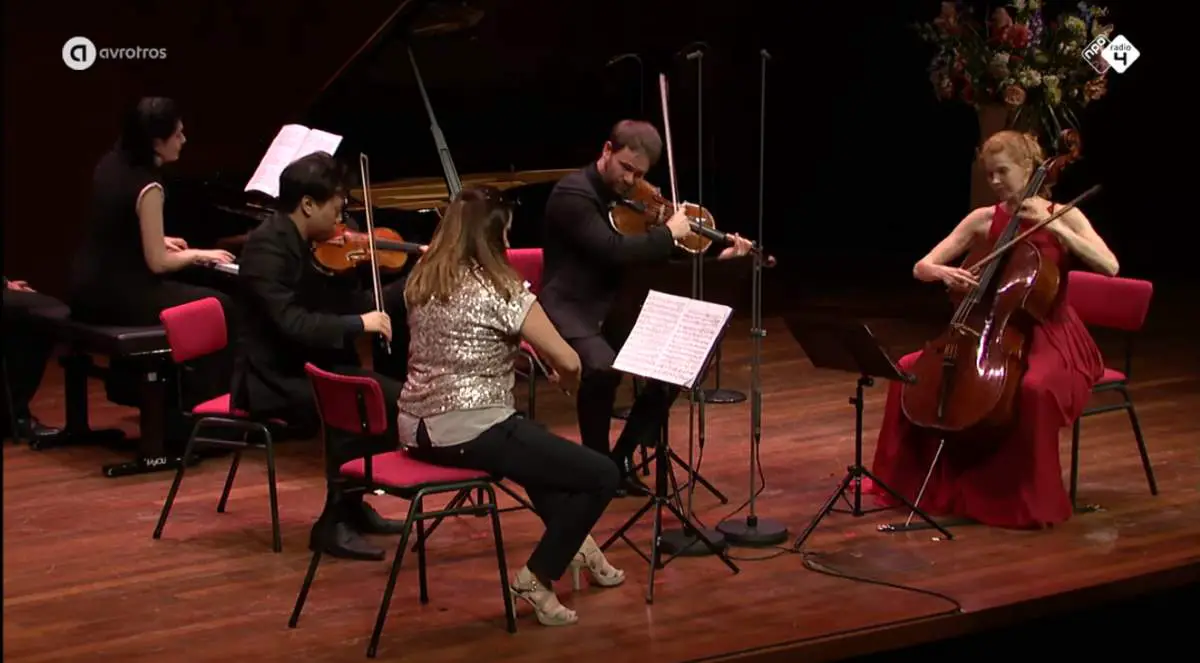Alasdair Beatson (piano), Tang Tee Khoon (violin), Yang Shuxiang (violin), Julianne Lee (viola), and Eckart Runge (cello) perform Antonin Dvořák’s Piano Quintet No. 2 in A major, Op. 81. This performance was recorded on November 11, 2023.
Antonin Dvořák’s Piano Quintet No. 2
Antonín Dvořák’s Piano Quintet No. 2 in A major, Op. 81, is a celebrated chamber music work, written in 1887 and stands out as one of his most popular and beloved compositions. The quintet showcases Dvořák’s signature style, which masterfully blends traditional classical forms with the folk music elements of his Czech heritage.
Dvořák composed this quintet during a period of intense creativity and nationalistic pride, which is reflected in the music’s rich melodic content and rhythmic diversity reminiscent of Czech folk dances and songs. The quintet was actually a revision of an earlier work he composed in 1872, which he was not entirely satisfied with. The result of this revision was a piece that not only improved upon the structure and thematic material but also exuded a more refined and cohesive musical expression.
The composition for piano, two violins, viola, and cello allows for a rich interplay of textures and timbres, creating a vibrant and dynamic sonic palette. Dvořák’s expertise in orchestration is evident in the way he balances the voices of the piano and strings, neither allowing the piano to overpower the strings nor the strings to overshadow the piano.
This quintet is particularly noted for its lyrical beauty and the emotional depth of its themes. It embodies a mix of exuberance and introspection, with themes that are at once joyous and melancholic, mirroring the complexity of human emotions. The work is also celebrated for its structural innovation, featuring a sophisticated use of cyclic form, where thematic material from one movement reappears in another, providing unity and coherence to the overall composition.
Dvořák’s Piano Quintet No. 2 remains a staple in the chamber music repertoire, admired for its emotional range and the flawless integration of traditional and folk elements, making it a quintessential example of the Romantic era’s spirit and one of Dvořák’s most enduring and cherished contributions to classical music.
Movements
1. Allegro, ma non tanto
The first movement of Dvořák’s Piano Quintet No. 2 in A major, Op. 81, is marked “Allegro, ma non tanto,” which translates to “fast, but not too much.” This movement opens with a lyrical and expressive theme introduced by the cello, immediately setting a warm and inviting tone. The piano quickly joins in, expanding on the theme and integrating seamlessly with the string ensemble.
This movement is structured in sonata form, a common choice for the opening movements of classical chamber music, comprising an exposition, development, and recapitulation. The exposition introduces two contrasting themes: the first is rich and melodious, full of Slavic warmth and lyricism, while the second theme is lighter and more dance-like, reflecting Dvořák’s incorporation of Czech folk elements into classical forms.
The development section sees these themes being explored and varied, showcasing Dvořák’s skill in thematic development and transformation. The music increases in complexity, weaving intricate dialogues between the piano and strings. This section builds in intensity, exploring a range of emotions and culminating in a climactic passage that leads seamlessly into the recapitulation.
In the recapitulation, the main themes return but are now deepened and enriched by the journey they have undergone during the development. This reprise brings a sense of familiarity mixed with a deeper emotional resonance, a hallmark of Dvořák’s compositional style. The movement concludes with a coda that reiterates the main theme, bringing the movement to a satisfying and cohesive close.
2. Dumka: Andante con moto
The second movement of Dvořák’s Piano Quintet No. 2 in A major, Op. 81, is marked “Dumka: Andante con moto,” and it is particularly notable for its use of the “Dumka” form, which is a Slavic musical term denoting a lament, traditionally characterized by a melancholic and introspective quality interspersed with brighter, more spirited sections.
This movement showcases Dvořák’s deep connection to his Czech roots through the evocative and plaintive melodies that are typical of the Dumka style. It starts with a somber and expressive theme played by the piano, which sets a reflective tone. This theme is then taken up and elaborated by the strings, adding depth and emotional complexity to the initial statement.
The structure of the Dumka allows for a contrast between the sorrowful main theme and more animated, dance-like interludes. These lighter sections provide a temporary relief from the movement’s overall melancholy, featuring rhythmic and lyrical motifs that hint at traditional Czech dances. The interplay between the minor and major keys in these sections adds a dynamic quality to the movement, creating a rich tapestry of mood and texture.
As the movement progresses, the initial lamenting theme returns, but each time it is varied and developed, showing Dvořák’s skill in thematic transformation and development. The interjections of brighter music become more integrated with the somber melodies, weaving a complex emotional narrative that is both poignant and uplifting.
The second movement of the quintet stands out for its dramatic contrasts and the profound depth of its emotional expression. It captures the essence of the Dumka with its juxtaposition of reflective melancholy and resilient spirit, making it a central and memorable part of Dvořák’s Piano Quintet No. 2.
3. Scherzo (Furiant): molto vivace
The third movement of Dvořák’s Piano Quintet No. 2 in A major, Op. 81, is marked “Scherzo (Furiant): Molto vivace,” and it is a vibrant and energetic piece that brings a stark contrast to the introspective Dumka of the second movement. This movement draws upon the Furiant, a fiery and fast-paced Czech folk dance, known for its rhythmic complexity and vigorous spirit.
The movement opens with a spirited and syncopated theme that immediately captures the essence of the Furiant. The piano and strings engage in a lively exchange, with the piano often driving the rhythm forward while the strings provide a rich melodic counterpoint. The Scherzo’s main theme is characterized by sharp, dynamic accents and sudden changes in dynamics, which convey a sense of excitement and spontaneity.
Central to this movement is the contrast between the vigorous main sections and the more lyrical trio section. The trio provides a brief respite from the relentless energy of the Scherzo, featuring smoother, more flowing lines that offer a melodic and rhythmic contrast. This section maintains the lively tempo but softens the mood with its lyrical quality, showcasing Dvořák’s ability to weave contrasting musical ideas into a cohesive whole.
After the trio, the initial Furiant theme returns, reinvigorating the movement with its robust energy. The movement drives towards a thrilling conclusion, with the themes intertwining and building in intensity. The Scherzo ends as it began, with a burst of energy and a final, emphatic statement from the ensemble.
4. Finale: Allegro
The fourth and final movement of Dvořák’s Piano Quintet No. 2 in A major, Op. 81, is marked “Finale: Allegro,” and it serves as a powerful and exhilarating conclusion to the entire work. This movement combines elements of rondo and sonata forms, creating a structure that allows for both thematic development and the return of familiar material, which provides a sense of closure and culmination.
The movement opens with a jubilant and assertive theme that sets a festive and celebratory tone. This theme is bright and rhythmic, featuring bold, accented notes and a lively tempo that propels the music forward. The piano and strings interact closely, with the piano often leading with vigorous, chordal passages while the strings respond with lyrical and sweeping lines.
Throughout the movement, Dvořák introduces a series of contrasting themes and motifs, which he develops and intertwines with the opening material. These include more lyrical passages that recall the emotional depth of the earlier movements, particularly the second movement’s Dumka. This blending of the joyous with the introspective gives the finale a rich, multi-faceted character.
The use of rondo form in this movement means that the main theme returns several times, each return acting as an anchor amidst the musical explorations. These returns are varied each time, infused with new vitality and often more complexity, which keeps the movement dynamic and engaging. As the movement builds towards its climax, Dvořák ramps up the tempo and intensity, leading to a vigorous and satisfying conclusion.
The final movement of the Piano Quintet No. 2 encapsulates the essence of Dvořák’s compositional style-his ability to meld lyrical beauty with rhythmic vitality and his masterful integration of folk elements into classical forms. It ends the quintet on a high note, leaving a lasting impression of both joy and profound musical substance.
Musicians

Alasdair Beatson
Scottish pianist Alasdair Beatson is renowned as a sincere musician and intrepid programmer. He champions a wide repertoire with particular areas of interest: classical, early romantic, and French music (especially Fauré), alongside the music of today’s composers. A prolific chamber musician, Alasdair’s colleagues include Steven Isserlis, Pekka Kuusisto, Viktoria Mullova, Pieter Wispelwey, the Doric, Gringolts, and Meta4 string quartets, and the Nash Ensemble.
Recent recordings include works of Beethoven and Schubert for violin and fortepiano with Viktoria Mullova, and a solo piano recital Aus Wien on Pentatone. These join a discography of solo and chamber recordings on BIS, Champs Hill, Claves, Evil Penguin, Pentatone, and SOMM labels. Performances during 2022/23 include regular appearances at Wigmore Hall, and at festivals including Cheltenham, Ernen, Festivalta, Lewes, O/Modernt, Resonances, Spitalfields, and Yellowbarn. Alasdair is the artistic director of the chamber music festival at Musikdorf Ernen in Switzerland.
Tang Tee Khoon
Described as a chamber musician of the highest order, and a ‘national treasure’, her playing as ‘truly transcendent’, Tang Tee Khoon was named one of the 40 under 40 faces to watch by Prestige Singapore and The Peak Power List 2021 Next Gen Women. She was the second-ever violinist to be awarded the loan of a J.B. Guadagnini violin c. 1750 by the National Arts Council in Singapore from 2009-2017.
Tee Khoon performs internationally as a recitalist and a chamber musician and has collaborated with musicians such as Midori, Hsin-Yun Huang, Ian Swenson, and members of the Emerson, Takács, and Borromeo String Quartets. Her festival appearances include Seiji Ozawa’s International Music Academy in Switzerland and Open Chamber Music at Prussia Cove U.K.
Founder of Chamber Music and Arts Singapore, Tee Khoon plays on a Stefan-Peter Greiner violin c.2006.
Yang Shuxiang
A musical chameleon, Yang Shuxiang leads the conductorless re:Sound Chamber Orchestra while maintaining solo and chamber music activities across Asia and beyond, appearing at festivals and concert series such as the Perlman Music Program, Boston Music Institute, Macao Arts Festival and Music for Food Taiwan.
Shuxiang recently co-founded a novel string quartet concept with collaborators David Loke and Martin Peh: the Bards of Neverland – to tell impossible stories from impossible times and places through genre-bending programming, visuals, and settings – integrating into large-scale post-classical/quasi-pop productions e.g. Wondrous Fall (VR production), Northern Lights, Alex Blake Charlie and Tapestry.
Shuxiang holds a Doctor of Musical Arts degree from the New England Conservatory, where he served as teaching assistant to Donald Weilerstein.
Julianne Lee
Julianne Lee has a distinctive career as both a violinist and violist, appearing frequently as a soloist, chamber musician, and orchestral player.
A member of the violin section of the Boston Symphony Orchestra since 2006, she currently holds the position of assistant principal second violinist with the BSO and principal second violin of the Boston Pops Orchestra. Julianne Lee has also toured internationally with the Australian Chamber Orchestra, where she held the title of guest principal violist and as of September 2023, Julianne is violist of the Grammy-nominated Dover Quartet.
Throughout her career, she has performed as a chamber musician at the Santa Fe Chamber Music Festival, Marlboro Music Festival, Chamber Music at the Banff Centre, and Aspen Music Festival. Beginning in 2023-24, Julianne joins the faculty at Curtis as a member of the Dover Quartet, the institute’s ensemble-in-residence.
Eckart Runge
Eckart Runge has established himself as one of the most versatile cellists of his generation. After marking the characteristic profile of the internationally-acclaimed Artemis Quartet for three decades, Eckart left the quartet in 2019 for new artistic challenges – with prestigious concert series such as BASF Ludwigshafen (2022), ‘Die Glocke’ Bremen (2022-24) and Konzerthaus Berlin (from 2024) appointing him as Artist-in-Residence.
His first solo album with the radio orchestra Berlin (RSB) released in 2020 featured the world premiere recording of Nikolai Kapustin’s jazzy cello concerto Op. 85 as well as the passionate 1st concerto by Alfred Schnittke and was awarded the prestigious ‘Prize of German Music Critics’.
In 2021, his Duo Runge & Ammon released a new album ‘Revolutionary Icons’ (Berlin Classics) exploring Beethoven in the reflection of revolutionary rock-pop-jazz icons like Jimi Hendrix, Frank Zappa, and Miles Davis.
Sources
- Piano Quintet No. 2 (Dvořák) on Wikipedia
- Piano Quintet No. 2, Op. 81 (Dvořák, Antonín) on the International Music Score Library Project website
- Piano Quintet No. 2 in A major, Op. 81, B155 on the Antonín Dvořák website
- Beethoven: Piano Concerto No. 3 [Olga Scheps] - April 30, 2024
- Händel: Dixit Dominus [hr-Sinfonieorchester, Chœur du Concert D’Astrée, Emmanuelle Haïm] - April 29, 2024
- Händel: Solomon [Radio Filharmonisch Orkest, Groot Omroepkoor, Peter Dijkstra] - April 28, 2024



